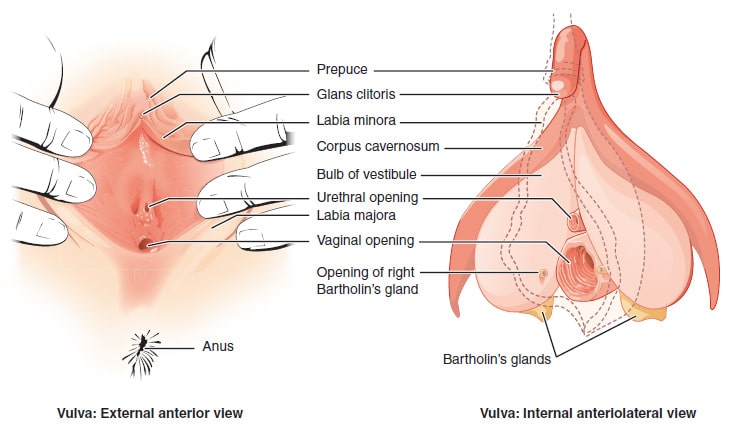The labia are part of the female genitalia; they are the major externally visible portions of the vulva. There are two pairs of labia: the labia majora (or the outer labia) are larger and fattier, while the labia minora are folds of skin between the outer labia. The labia surround and protect the clitoris and the openings of the vagina and the urethra.
The labia majora, also commonly called outer labia or outer lips, are lip-like structures consisting mostly of skin and adipose (fatty) tissue, which extend on either side of the vulva to form the pudendal cleft through the middle. The labia majora often have a plump appearance, and are thicker towards the anterior. The anterior junction of the labia majora is called the anterior commissure, which is below the mons pubis and above the clitoris. To the posterior, the labia majora join at the posterior commissure, which is above the perineum and below the frenulum of the labia minora.
The labia minora, also called inner labia or inner lips, are two soft folds of fat-free, hairless skin between the labia majora. They enclose and protect the vulvar vestibule, urethra and vagina. The upper portion of each labium minora splits to join with both the clitoral glans, and the clitoral hood. The labia minora meet posterially at the frenulum of the labia minora (also known as the fourchette), which is a fold of skin below the vaginal orifice. The fourchette is more prominent in younger women, and often recedes after sexual activity and childbirth.
When standing or with the legs together, the labia majora usually entirely or partially cover the moist, sensitive inner surfaces of the vulva, which indirectly protects the vagina and urethra, much like the lips protect the mouth. The outer surface of the labia majora is pigmented skin, and develops pubic hair during puberty. The inner surface of the labia majora is smooth, hairless skin, which resembles a mucous membrane, and is only visible when the labia majora and labia minora are drawn apart.
Both the inner and outer surfaces of the labia majora contain sebaceous glands (oil glands), apocrine sweat glands, and eccrine sweat glands. The labia majora have fewer superficial nerve endings than the rest of the vulva, but the skin is highly vascularized. The internal surface of the labia minora is a thin moist skin, with the appearance of a mucous membrane. They contain many sebaceous glands, and occasionally have eccrine sweat glands. The labia minora have many sensory nerve endings, and have a core of erectile tissue.

By OpenStax College – Anatomy & Physiology, Connexions Web site Creative Commons 3.0 License
Labia. (2016, September 30). In Wikipedia, The Free Encyclopedia. Retrieved 07:21, September 30, 2016, from https://en.wikipedia.org/w/index.php?title=Labia&oldid=741881654
